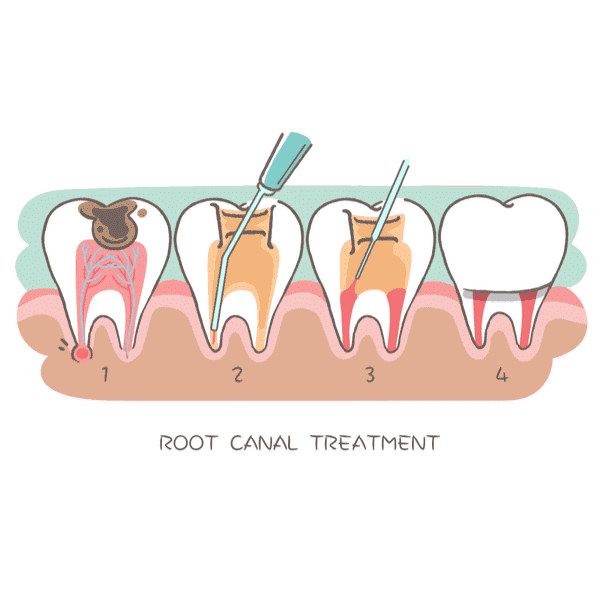For many people, there are two words that can immediately cause shivers of fear: root canal. But the truth is far from terrifying. With modern medicine and experienced dentists providing high quality care, a root canal is a relatively painless procedure that alleviates a huge amount of discomfort. What should you really expect with a root canal treatment, and how long does a root canal take?
In this blog, we aim to demystify what a root canal treatment is, when you might need one, and what to expect before and after the procedure.
What Is A Root Canal?
Technically speaking the root canal is part of the tooth – but to make things easy we will use ‘root canal’ and ‘root canal treatment’ to mean the same thing.
Root canal treatments, also called endodontic treatments, remove infected tooth pulp to stop infection spreading and save as much of the tooth as possible. Every tooth has a coating of white enamel outside a hard layer of dentine. Those two layers protect the pulp, soft tissue inside your teeth containing blood vessels and nerve endings.
The pulp connects to surrounding tissue. While it is important for growing teeth, fully formed teeth can survive without pulp.
Did you know: The word endodontic comes from two Greek words: Endo or ‘inside’, and odont or ‘tooth’.
When Do You Need A Root Canal?
When the pulp inside a tooth becomes infected or inflamed, a root canal treatment removes the painful matter and seals the tooth to prevent further infection. Left unchecked, pulp infections can spread to the jaw, throat and further into the body.
Pulp can become infected in several ways:
- Sudden mouth injury
- Unmanaged decay
- Built up bacteria causing infection
- Cracked or chipped teeth
Signs you may need a root canal
- Chipped or cracked teeth
- Severe localised pain while biting or chewing
- Swollen, red or sensitive gums
- Gum pimples or abscesses
- Sensitivity to hot and cold
- Decay or darkening of tooth and gum
What Is The Root Canal Procedure?
Far from the painful barbaric treatment you might imagine, root canal treatments are straightforward endodontic procedures performed in the dentist’s chair.
How do we schedule the appointments?
Root canals take 3-4 appointments scheduled 3-4 weeks apart. Each appointment ranges between 30-75 minutes. The appointments are spaced this far apart because, although antibiotic paste is placed in the tooth, time is also needed to allow the body time to heal on its own naturally.
Once the dentist has taken x-rays to confirm the infection, a root canal involves 7 steps:
- Dentist applies local anaesthetic to numb the area
- Using a small drill the dentist opens the tooth to expose the infected pulp
- Damaged or diseased pulp is cleared away
- When the tooth chamber is cleaned and dried, the dentist applies an antibiotic paste and then a temporary filling
- A few weeks after a patient returns to have the root canals shaped (there can be up to 4 in a molar and as few as 1 in a front tooth). The canals need to be shaped to fit the filling material, which is placed at a later stage. Antibiotic paste and a temporary filling is placed again.
- A few weeks later the patient returns for a dressing change. The antibiotic paste is placed again to rule out any risk of the tooth re-infecting. It’s important to fully ensure that the tooth is bacteria free before permanently sealing it up.
- A final appointment is scheduled 4 weeks later for the root canal to be completed. This procedure will seal up the canals. Then a permanent filling is placed.
Root Canals & Dental Crowns
A root canal and crown go hand in hand with each other. You can’t really have one without the other. A root treated tooth has had its nerve and blood supply removed due to infection. This means the tooth can become dry and brittle over time. There is also filling material in the root and the natural crown of the tooth.
A crown will offer the tooth some support. We always quote both procedures before commencing treatment, because we want our patients to always be aware of the connection between both procedures and to understand the importance of having both.
A root treated tooth can potentially split straight through the middle. The patient is left with two clean halves from crown to tip (or apex of the tooth). A crown acts like a helmet to keep everything together. We offer interest free payment plans for costly procedures such as root canals and crowns.
Root Canal Or Extraction?
Up front, root canals are considerably more expensive than extraction and filling. In the long run, however, if you have the tooth extracted eventually it will cost more. If you remove a tooth, the other teeth will fall over to fill the open space, similar to a bookshelf.
Therefore, the tooth will need to be replaced with either an implant or denture. Implants are a great solution but can be expensive. We always aim to keep natural tooth structure in place where possible. No dental technique can replicate a natural tooth structure.
Most patients prefer to avoid dentures where possible as it can impact their eating habits, overall self-esteem and confidence. By choosing a root canal treatment over an extraction, chances are that you are saving in the long run.
Prevention
Root canal treatments relieve pain and offer a more preferable long term solution to extracting a tooth. Still, most people would prefer to not need one at all. And the good news is root canals are often entirely preventable. With regular dentist visits, diligent at-home dental care and a healthy diet low in sugary foods and rich drinks, you can minimise the risk of infection.
If you do need a root canal procedure, rest assured that the Midland Dental Hub team will provide the highest level of care. We understand the reluctance to treat root canals which is why we strive for a pain-free treatment. We hop to give you plenty of reasons to smile. Call our Midland Dental Clinic today.
Root Canal Frequently Asked Questions
How long does a complete root canal treatment take from start to finish?
A complete root canal treatment at Midland Dental Hub typically requires 3-4 appointments scheduled 3-4 weeks apart. A typical appointment takes roughly 45 minutes. The entire process from initial appointment to final sealing takes approximately 9-16 weeks, allowing time for the body to heal naturally between treatments.
Is a root canal treatment painful?
Contrary to popular belief, modern root canal treatments are relatively painless procedures. Local anaesthetic is applied to numb the area completely before any work begins.
Why are root canal appointments spaced weeks apart?
The appointments are spaced 3-4 weeks apart to allow the antibiotic paste placed in the tooth to work effectively and to give your body time to heal naturally.
Do I need a crown after a root canal treatment?
Yes, a crown is strongly recommended after a root canal treatment. A root-treated tooth becomes dry and brittle over time as its blood supply has been removed. A crown acts like a protective helmet to prevent the tooth from splitting and provides necessary support for long-term tooth preservation.
What are the signs that I might need a root canal?
Signs you might need a root canal include severe localised pain while biting or chewing, swollen or sensitive gums, gum pimples or abscesses, sensitivity to hot and cold, darkening of the tooth, and chipped or cracked teeth. If you experience these symptoms, contact a dentist immediately.
Are there payment plans available for root canal treatments?
Yes, Midland Dental Hub offers interest-free payment plans under certain conditions making treatments more accessible for patients. Find more information on our Payment Plans page.
How can I prevent needing a root canal in the future?
Root canals are often preventable with regular dental check-ups, diligent at-home dental care including proper brushing and flossing and maintaining a healthy diet low in sugary foods and rich drinks. These practices help avoid the infections that lead to root canal treatments.
When do you need a root canal? (infographic)


